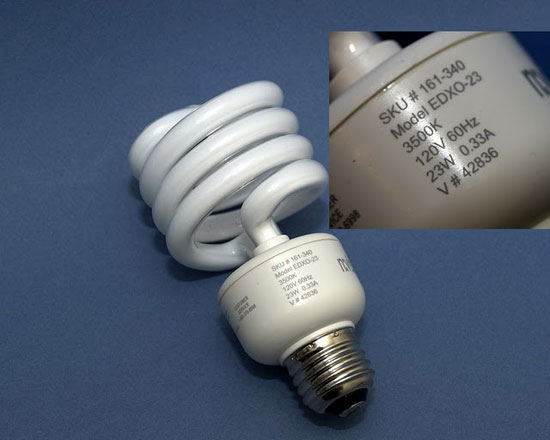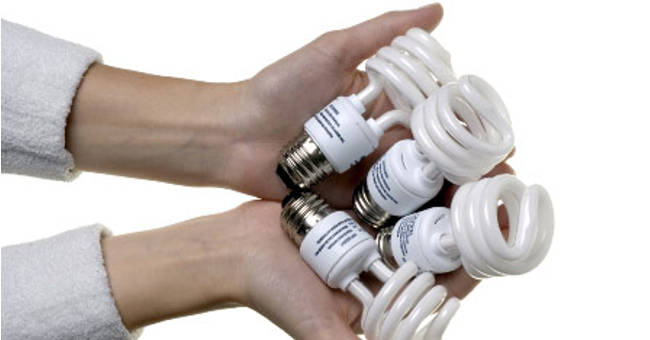Potential hazards inside energy-saving compact fluorescent light bulbs
Compact bulbs are chosen by many consumers because of the advantages of saving and reducing pollution. However, few people know that each compact fluorescent lamp contains about 5 mi - grams of mercury enough to pollute 22680 liters of drinking water.
If unfortunately for compact light bulbs to crack and break, mercury, phosphorus powder in the ball will escape to harm the environment and human health.

As long as these energy saving compact bulbs still work well, meaning that the amount of toxic mercury is still contained in the light bulb, it won't cause problems, but when these compact bulbs are damaged. They will become a real threat to the environment and human health if they are not properly cleaned and treated.
1. Harmful to health
If a compact bulb is broken for any reason, it means that 5 mi - grams of toxic mercury will be released into the environment, and directly affect the health of people who come in contact with it by chance.
As recommended by the US Environmental Protection Agency (EPA): Low mercury exposure (less than 5 milligrams) can cause tremors, mood changes, insomnia, muscle fatigue, and headache. If exposed to high doses or long-term exposure, it can lead to cretinism, personality changes, deafness, memory loss, and even chromosomal damage; Neurons, brain, and kidneys will also be badly damaged. This toxic mercury also directly affects the nervous system of the fetus and children.

Energy-saving compact bulbs contain extremely toxic mercury.(Illustration)
2. The danger to the environment
The US Environmental Protection Agency (EPA) claims that in the United States alone, more than one billion energy-saving compact bulbs are thrown into the bin each year. In some areas, some energy-saving compact bulbs are broken. As a result, significant amounts of mercury from these broken bulbs spread into the air, water and soil. Mercury can leak into the water system or float in the air to the surface of soil layers, so toxic mercury is present: the fish we eat and the water we drink .
Scientists at the company Lenntec (water and air treatment company, headquartered in Delft, Netherlands) explained that: most of the agricultural fertilizers contaminated with mercury are absorbed by the The fruits and vegetables we eat every day. Animal feeds and drinking water can also be contaminated with mercury and then humans eat mercury-contaminated animals.
3. The danger to animals
Animals raised on farms and wild animals are also affected by mercury. Mercury spreads into water and penetrates into fish and other animals when they drink water contaminated with mercury. Research results conducted by scientists working at Lenntec company show that: exposure to mercury is related to the ability to miscarry and change DNA in animals, as well as to destroy organs in animals such as kidneys, stomach and intestines.
Proper cleaning and handling solutions for damaged energy-saving compact bulbs
If a compact light bulb breaks, the US Environmental Protection Agency (EPA) recommends that you open the window and leave the room for at least fifteen minutes .
You should turn off the heater and air conditioning system. Absolutely do not use a brush or vacuum cleaner to clean the liquid that spills from the bulb, as doing so may release more mercury into the air. Carefully take the broken glass pieces and place them in a glass jar with a metal lid or in a sealed plastic bag. Use adhesive tape to remove small debris. Put these debris in jars, bags, and packaging carefully. Contact your local government for specific instructions on how to handle these materials.
The benefits of using energy-saving compact bulbs are in contrast to human health risks that may be encountered. Energy-saving light bulbs can be valuable, but their toxicity needs to be acknowledged and checked.
- India launches the campaign
- VN-Venezuela produces electricity-saving light bulbs
- Responding to climate change from ... light bulbs
- Use free energy-saving light bulbs
- Radiant energy-saving light bulbs can be harmful
- When should I use compact fluorescent light bulbs?
- You may not believe it but the replacement of the LED lamp is an incandescent light
- Anti-theft light bulb
- Hazard warning from compact light bulbs
- New light bulbs save up to 80% electricity compared to LED lights, whichever is plugged into
- OLED bulbs - lighting equipment in the future
- Super power-saving light bulb
 Green tea cleans teeth better than mouthwash?
Green tea cleans teeth better than mouthwash? Death kiss: This is why you should not let anyone kiss your baby's lips
Death kiss: This is why you should not let anyone kiss your baby's lips What is salmonellosis?
What is salmonellosis? Caution should be exercised when using aloe vera through eating and drinking
Caution should be exercised when using aloe vera through eating and drinking